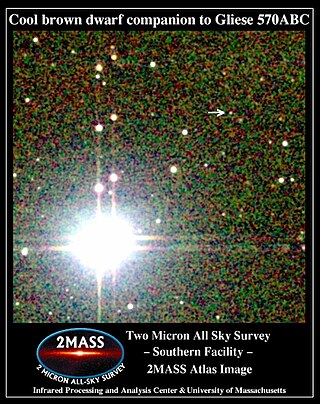 The quaternary star system Gliese 570. The T-type methane brown dwarf Gliese 570D is indicated with an arrow. Credit: 2MASS | |
| Observation data Epoch J2000.0 Equinox J2000.0 | |
|---|---|
| Constellation | Libra |
| Right ascension | 14h 57m 28.00144s[1] |
| Declination | −21° 24′ 55.7131″[1] |
| Apparent magnitude (V) | 5.75 / 8.07 / 10.5 |
| Characteristics | |
| Spectral type | K4V / M1V / M3V / T7V |
| U−B color index | 1.06 /1.22 |
| B−V color index | 1.11 / 1.51 |
| Variable type | None |
| Astrometry | |
| A | |
| Radial velocity (Rv) | +26.75±0.12[2] km/s |
| Proper motion (μ) | RA: 1031.472 mas/yr[2] Dec.: -1723.619 mas/yr[2] |
| Parallax (π) | 169.8843 ± 0.0653 mas[2] |
| Distance | 19.199 ± 0.007 ly (5.886 ± 0.002 pc) |
| Absolute magnitude (MV) | 6.89[3] |
| BC | |
| Radial velocity (Rv) | +25.9[4] km/s |
| Proper motion (μ) | RA: 961.78[1] mas/yr Dec.: -1677.83[1] mas/yr |
| Parallax (π) | 168.77 ± 21.54 mas[1] |
| Distance | approx. 19 ly (approx. 5.9 pc) |
| Absolute magnitude (MV) | 9.19[3] / 11.05 |
| D | |
| Proper motion (μ) | RA: 1038.08[5] mas/yr Dec.: -1677.59[5] mas/yr |
| Parallax (π) | 169.30 ± 1.70 mas[6] |
| Distance | 19.3 ± 0.2 ly (5.91 ± 0.06 pc) |
| Absolute magnitude (MV) | 11.05[citation needed] |
| Details | |
| Mass | 0.802 ± 0.040[7] / 0.55 / 0.35 / 0.05 M☉ |
| Radius | 0.739 ± 0.019[7] / 0.65 R☉ |
| Luminosity (bolometric) | 0.22[note 1] / 0.04 / ? / 3•10−6[8] L☉ |
| Luminosity (visual, LV) | 0.16 / 0.02 / 0.003 / ? L☉ |
| Temperature | 4597 ± 101[7] / 2700 K |
| Metallicity | [7] |
| Rotation | 48.3 days |
| Rotational velocity (v sin i) | 1.50[7] km/s |
| Other designations | |
| A: HR 5568, LAL 27173, HD 131977, BD-20°4125, LHS 387, LTT 5949, GCTP 3375.00, SAO 183040, FK5 1391, LFT 1161, LPM 551, Vys 726, HIP 73184 | |
| BC: HD 131976, HIP 73182, LHS 386, LTT 5948, BD-20°4123, SAO 183039, LFT 1160, LPM 550 | |
| D: 2MASS J14571496-2121477 | |
| Database references | |
| SIMBAD | A |
| BC | |
| D | |
| Exoplanet Archive | data |
| ARICNS | data |
Gliese 570 (or 33 G. Librae) is a quaternary star system approximately 19 light-years away. The primary star is an orange dwarf star (much dimmer and smaller than the Sun). The other secondary stars are themselves a binary system, two red dwarfs that orbit the primary star. A brown dwarf has been confirmed to be orbiting in the system. In 1998, an extrasolar planet was thought to orbit the primary star, but it was discounted in 2000.
- ^ a b c d e Cite error: The named reference
aaa474_2_653was invoked but never defined (see the help page). - ^ a b c Cite error: The named reference
dr3awas invoked but never defined (see the help page). - ^ a b Cite error: The named reference
Holmberg2009was invoked but never defined (see the help page). - ^ Cite error: The named reference
rvbcwas invoked but never defined (see the help page). - ^ a b Cite error: The named reference
weinberger2016was invoked but never defined (see the help page). - ^ Cite error: The named reference
faherty2012was invoked but never defined (see the help page). - ^ a b c d e Cite error: The named reference
aaa505was invoked but never defined (see the help page). - ^ Cite error: The named reference
ammoniapaperwas invoked but never defined (see the help page).
Cite error: There are <ref group=note> tags on this page, but the references will not show without a {{reflist|group=note}} template (see the help page).

![{\displaystyle {\begin{smallmatrix}\left[{\frac {Fe}{H}}\right]\ =\ 0.06\end{smallmatrix}}}](https://wikimedia.org/api/rest_v1/media/math/render/svg/1140bc04e494a2dfd4b5af2027e7b9976f913fe3)